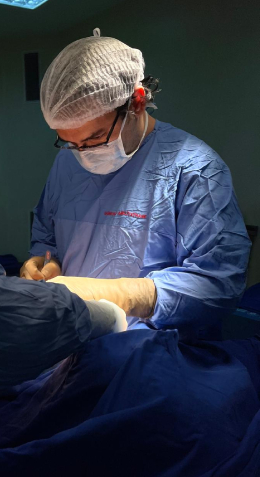Face and Neck Lift

Face and Neck Lift
A neck lift, also known as lower rhytidectomy, is a cosmetic surgical procedure designed to improve the appearance of the neck by removing excess skin and fat, tightening the underlying muscles, and smoothing out wrinkles. It is often chosen by individuals seeking to address sagging skin, muscle laxity, or excess fat deposits in the neck area.
Procedure
During a neck lift, incisions are typically made behind the ears and under the chin, allowing the surgeon access to the underlying tissues. Excess fat may be removed through liposuction, while loose skin is trimmed away. The underlying muscles may also be tightened to create a more defined jawline and smoother neck contour. The incisions are then closed with sutures, and the patient is typically advised to rest and avoid strenuous activities during the recovery period.
Benefits
People choose neck lift surgery for various reasons, including:
- Improved Appearance: A neck lift can significantly enhance the appearance of the neck by reducing sagging skin, eliminating excess fat, and creating a more youthful profile.
- Enhanced Confidence: Many individuals feel more confident and satisfied with their appearance after undergoing a neck lift, leading to improved self-esteem and quality of life.
- Long-Term Results: While the aging process will continue, the results of a neck lift can be long-lasting, especially when combined with healthy lifestyle habits such as proper skincare and sun protection.
Risks and Considerations
Like any surgical procedure, a neck lift carries some risks, including:
- Scarring: While efforts are made to minimize scarring, some visible scars may remain after the procedure.
- Infection: Infection is a potential risk following any surgical procedure. Patients are typically prescribed antibiotics to reduce this risk.
- Nerve Damage: There is a small risk of temporary or permanent nerve damage, which could lead to numbness, weakness, or altered sensation in the neck area.
Who Should Consider a Neck Lift?
A neck lift may be suitable for individuals who:
- Are bothered by excess skin or fat in the neck area
- Have realistic expectations about the outcome of the procedure
- Are in good overall health and do not smoke
- Understand the potential risks and complications associated with surgery
Post-Surgery Care
After a neck lift, it's important to follow your surgeon's instructions carefully to ensure optimal healing and results. Some general guidelines include:
- Avoiding strenuous activities for several weeks
- Keeping the incision sites clean and dry
- Avoiding smoking and alcohol consumption, as these can interfere with the healing process
- Using sunscreen to protect the skin from sun damage
In conclusion, a neck lift can be an effective way to rejuvenate the appearance of the neck and improve self-confidence. While it does carry some risks, with proper care and attention, many people find it to be a worthwhile investment in their appearance and well-being.
What is a facelift?
A facelift, medically known as rhytidectomy, is a cosmetic surgical procedure designed to rejuvenate the face by reducing the visible signs of aging. It involves lifting and tightening the facial tissues and muscles, as well as removing excess skin to create a smoother, more youthful appearance. Facelifts are popular among individuals seeking to address sagging skin, deep wrinkles, and other age-related changes in the face and neck.
Why people choose facelift?
As people age, the skin loses elasticity, and facial tissues may sag or droop due to gravity, sun exposure, and other factors. This can result in the formation of wrinkles, jowls, and loose skin around the jawline and neck. Facelifts offer a solution to these common concerns by restoring a firmer, more youthful contour to the face.
During a facelift procedure, incisions are typically made along the hairline and around the ears to minimize visible scarring. The surgeon then lifts and repositions the underlying facial muscles and tissues, removes excess skin, and sutures the incisions closed. In some cases, additional procedures such as liposuction or fat grafting may be performed to further enhance the results.
People choose facelifts for various reasons, including a desire to improve their appearance, boost self-confidence, and maintain a more youthful look as they age. Facelifts can address multiple signs of aging in the face, including sagging skin, deep folds, and loss of facial volume, resulting in a more refreshed and rejuvenated appearance.
While facelifts can provide dramatic and long-lasting results, they do carry certain risks and potential complications. These may include infection, bleeding, nerve damage, scarring, and unfavorable aesthetic outcomes. It's essential for individuals considering a facelift to thoroughly discuss these risks with their surgeon and ensure they choose a board-certified plastic surgeon with extensive experience in facial rejuvenation procedures.
Risks of the Facelift
Despite the risks, facelifts are generally considered safe when performed by a qualified surgeon in an accredited surgical facility. Ideal candidates for facelifts are typically in good overall health, non-smokers, and have realistic expectations about the outcome of the procedure. While age is not the sole determining factor, most facelift patients are in their 40s to 60s, although individuals of older age groups can also benefit from the procedure.
In conclusion, a facelift is a surgical procedure aimed at reversing the signs of aging and restoring a more youthful appearance to the face and neck. While it does carry some risks, it can provide significant aesthetic improvements for those seeking to rejuvenate their appearance and enhance their self-confidence. However, it's essential for individuals considering a facelift to thoroughly research the procedure, consult with a qualified surgeon, and carefully weigh the potential risks and benefits before making a decision.


